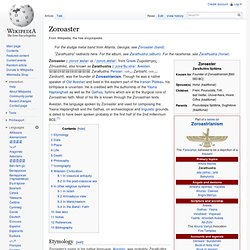

Religions - Zoroastrian: Under Persian rule. The Human Journey: Zoroaster. Zarathustra (or Zoroaster). This type of image emerged in the eighteenth century. Zarathustra, known to the Greeks as Zoroaster, lived about 1200 BCE, three hundred years before Karl Jasper’s Axial Age, yet aspects of what he taught transformed Aryan beliefs in a way that anticipated the Axial Prophets. His influence can still be seen in contemporary Judaism, Christianity and Islam more than 3,000 years after his estimated birth. Aryan society had for centuries been stable and peaceful. Places of Peace and Power - Zoroastrian Sacred Sites. Approach through the great desert to Chak Chak The primary religion in Iran today is the Shia sect of Islam but the far older faith of the prophet Zoroaster is still openly practiced, particularly in the central and northwestern regions of the country. Zoroaster's name in its original form is found in the sacred scripture the Avesta as Zarathushtra.
It is not possible to say exactly when he lived but contemporary scholarship has mostly agreed upon the dates of 660-583 BC, with his birthplace being in the region of northwestern Iran now known as Azerbaijan. Similar to other great sages of archaic times, Zoroaster's life is part history and part legend. Tales are told of signs in the sky announcing his coming, of marvels and omens attending his birth, and of acts of power that he performed as a young boy. Zoroaster was born in an age of agriculturalists and his religion is therefore deeply associated with the natural world. Zoroastrian temple of Pir-e-Naraki, near Yazd Pir-e-Sabz shrine. Kaufmann-haggadah-rooster-550.jpg 550×475 pixels. Encyclopædia Iranica. COCK, the male of the subfamily Phasianinae (pheasants), usually having a long, often tectiform tail with fourteen to thirty-two feathers.
The thirteen genera (twenty-nine species) of this subfamily all originated in Asia (Raethel, p. 49); one species, the red jungle fowl (Gallus gallus), the ancestor of the domestic chicken, lives in a variety of habitats in the wild, which probably facilitated its domestication (Raethel, p. 52), some time in antiquity. It was being exported from India to China in the 14th and 15th centuries b.c.e. (Lühmann, p. 55). Cocks are territorial birds and defend their hens and territories against other cocks, but, because they live in hierarchical groups, such fights are rarely fatal. Only “fighting cocks,” bred by humans for the purpose, continue fighting until they kill their adversaries (Lühmann, p. 56).
Bibliography: M. I. Ii. I. In Zoroastrianism the bird is sacred and may not be eaten (Šāyest ne šāyest 10.9, ed. 38209. The Bible-Primary Sources:The Book of Zoroaster (Vendidad)- Chapter 18. Book of Saphah: Basis of Vede. Sacred Texts Oahspe Index Previous Next Basis of Vede 1. VARIENA, a circle divided by cross-lines into four quarters; made for Thraetaono, a holy name, which had power over the Dahaka, serpent, i.e., evil. VENDIDAD (English): Fargard 18. 35. 'That man makes me conceive progeny as other males make their females conceive by their seed.' A Cock To Aesculapius by B P Wadia. Zoroastrianism. Religion ascribed to the teachings of Zoroaster With possible roots dating back to the Second Millennium BCE, Zoroastrianism enters written history in the 5th century BCE.[13] It served as the state religion of the ancient Iranian empires for more than a millennium, from around 600 BCE to 650 CE, but declined from the 7th century CE onwards following the Muslim conquest of Persia of 633–654 and subsequent persecution of the Zoroastrian people.

Recent estimates place the current number of Zoroastrians at around 110,000–120,000[15] at most, with the majority living in India, Iran, and North America; their number has been thought to be declining.[16][17] Parodarsh - Takshasila. Zoroaster. Zoroaster (/ˌzɒroʊˈæstər/ or /ˈzɒroʊˌæstər/, from Greek Ζωροάστρης Zōroastrēs), also known as Zarathustra (/ˌzɑrəˈθuːstrə/; Avestan: 𐬰𐬀𐬭𐬀𐬚𐬎𐬱𐬙𐬭𐬀 Zaraθuštra; Persian: زرتشت Zartosht, زردشت Zardosht), was the founder of Zoroastrianism.
